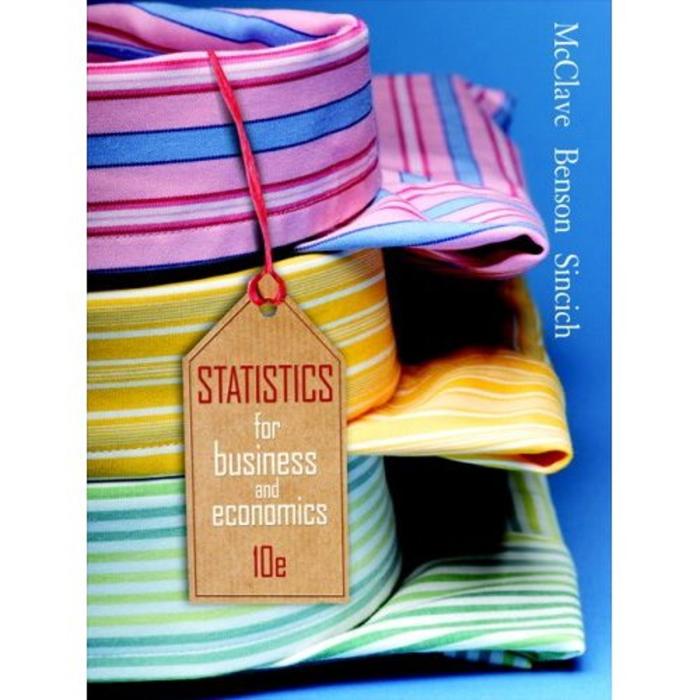Delve into the comprehensive guide of Statistics for Business and Economics 14th Edition Answers PDF, a resource that empowers you with the knowledge to navigate the complex world of business and economics. This definitive guidebook provides a thorough understanding of key statistical concepts and their practical applications, equipping you with the analytical tools to make informed decisions.
From data collection and analysis to probability and sampling, this invaluable resource covers a wide range of topics essential for business professionals and economics students alike. With its clear explanations, real-world examples, and comprehensive coverage, Statistics for Business and Economics 14th Edition Answers PDF sets the foundation for success in the dynamic fields of business and economics.
Chapter Overview
This chapter introduces the fundamental concepts of statistics for business and economics. It covers the basic principles of data collection, analysis, probability, sampling, statistical inference, regression analysis, and time series analysis. These concepts are essential for understanding how data is used to make informed decisions in business and economics.
Data Collection and Analysis

Data collection is the process of gathering information about a population. There are different methods of data collection, such as surveys, experiments, and observational studies. Once data is collected, it can be analyzed using various techniques, such as descriptive statistics, inferential statistics, and regression analysis.
Types of Data
- Quantitative data: Data that can be measured and expressed in numerical form.
- Qualitative data: Data that is non-numerical and describes characteristics or attributes.
Data Collection Methods, Statistics for business and economics 14th edition answers pdf
- Surveys: Collecting data from a sample of the population through questionnaires or interviews.
- Experiments: Manipulating variables to observe their effects on a dependent variable.
- Observational studies: Collecting data without manipulating variables.
Data Analysis Techniques
- Descriptive statistics: Summarizing and describing data using measures such as mean, median, and standard deviation.
- Inferential statistics: Using sample data to make inferences about the population.
- Regression analysis: Modeling the relationship between a dependent variable and one or more independent variables.
Probability and Sampling

Probability is the likelihood that an event will occur. It is used in business and economics to make predictions and assess risk. Sampling is the process of selecting a subset of a population to represent the entire population. Probability and sampling are closely related, as probability is used to calculate the likelihood that a sample is representative of the population.
Probability
- Definition: The likelihood that an event will occur.
- Range: 0 to 1.
- Types: Subjective probability (based on personal beliefs) and objective probability (based on data).
Sampling
- Definition: Selecting a subset of a population to represent the entire population.
- Types: Random sampling, stratified sampling, cluster sampling, and convenience sampling.
- Importance: Provides insights into the characteristics of the population.
Statistical Inference: Statistics For Business And Economics 14th Edition Answers Pdf

Statistical inference is the process of making an estimate or prediction about a population based on sample data. It involves using statistical tests to determine whether there is a significant difference between the sample and the population.
Types of Statistical Tests
- Hypothesis testing: Testing whether there is a significant difference between the sample and the population.
- Confidence intervals: Estimating the range of values within which the true population parameter is likely to fall.
- Regression analysis: Modeling the relationship between a dependent variable and one or more independent variables.
Applications of Statistical Inference
- Making predictions about future events.
- Assessing the effectiveness of marketing campaigns.
- Evaluating the impact of government policies.
Regression Analysis
Regression analysis is a statistical technique used to model the relationship between a dependent variable and one or more independent variables. It is used to make predictions and assess the impact of different factors on a dependent variable.
Types of Regression Models
- Simple linear regression: Models the relationship between a single dependent variable and a single independent variable.
- Multiple linear regression: Models the relationship between a single dependent variable and multiple independent variables.
- Logistic regression: Models the relationship between a binary dependent variable and one or more independent variables.
Applications of Regression Analysis
- Forecasting sales.
- Predicting customer behavior.
- Evaluating the effectiveness of marketing campaigns.
Time Series Analysis
Time series analysis is a statistical technique used to analyze data that is collected over time. It is used to identify trends, patterns, and seasonality in data, and to make predictions about future events.
Types of Time Series Models
- Moving averages: Smoothing data by averaging over a specified number of periods.
- Exponential smoothing: Smoothing data by weighting recent observations more heavily than older observations.
- ARIMA models: Autoregressive integrated moving average models that capture the trend, seasonality, and randomness in data.
Applications of Time Series Analysis
- Forecasting economic indicators.
- Predicting stock prices.
- Analyzing sales trends.
Question & Answer Hub
What are the key benefits of using Statistics for Business and Economics 14th Edition Answers PDF?
Statistics for Business and Economics 14th Edition Answers PDF offers a comprehensive understanding of statistical concepts, practical applications, and real-world examples, empowering users to make informed decisions and gain valuable insights in the fields of business and economics.
How can I access Statistics for Business and Economics 14th Edition Answers PDF?
The Statistics for Business and Economics 14th Edition Answers PDF is available online and can be accessed through various academic databases and reputable websites. It is recommended to consult your institution’s library or trusted online sources for the most up-to-date version.
Is Statistics for Business and Economics 14th Edition Answers PDF suitable for both students and professionals?
Yes, Statistics for Business and Economics 14th Edition Answers PDF is designed to cater to the needs of both students and professionals. Its clear explanations, engaging examples, and comprehensive coverage make it an accessible resource for individuals at various levels of statistical knowledge.